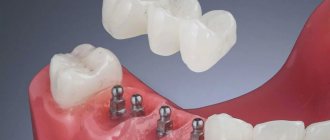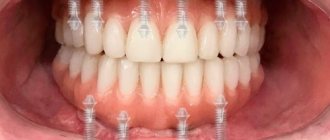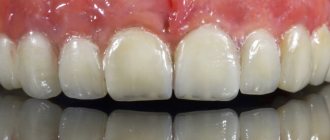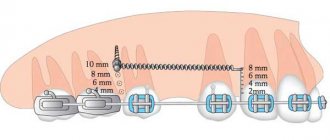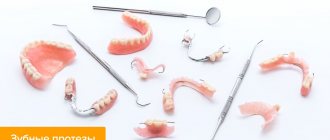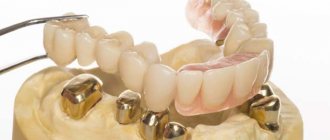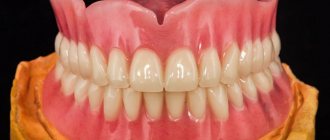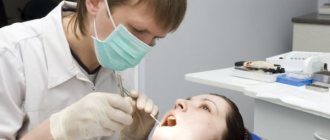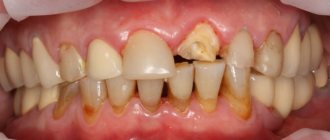Fixed dentures - features and advantages
Fixed dentures are considered the most effective and inexpensive solution to restore dentition.
The most common causes of tooth decay and subsequent loss are:
- abundant carious lesions;
- pulpitis;
- periodontitis;
- dental cysts, etc.
As a result of these dental diseases, tooth crowns and roots are destroyed, teeth fall out on their own, or surgical intervention is required to remove dead hard tissues and roots. For restoration, the dentist recommends permanent dental prosthetics, the basis of which is a bridge and ceramic crowns of the latest generation.
Advantages of fixed dentures:
- Aesthetics. Fixed dentures are difficult to distinguish from your teeth. With proper selection and proper installation, the design looks harmonious in the oral cavity, and the person smiles boldly.
- Comfort. A person quickly gets used to a fixed denture and does not feel discomfort afterwards.
- There is no need to build up bone for high-quality implementation of a fixed denture. When using modern artificial roots, there is often no need to build up bone tissue. This simplifies the entire dental procedure and makes it much more affordable.
- Fast payback. The investment in fixed dentures always pays off in dental health, attractive visual effect and durability.
Which dental prosthetics should you choose?
The choice of dental prosthetics method depends on the specific situation, the condition of the oral cavity, physiological characteristics, individual preferences and financial capabilities. If the teeth have external defects, but healthy roots, then it is possible to install veneers or crowns.
If 1-2 teeth are lost, they can be restored with a bridge or implants. If most of the dentition is lost (or cannot be restored), then there are 2 main options - acrylic removable dentures or complete dentures on implants using the All-on-4 system (i.e. “all on four”) or All-on -6 (i.e. “all on six”).
The main types of permanent dental crowns
At the stage of planning treatment with a fixed denture, the dentist, together with the patient, decides which type of fixed dental crown to use for high-quality prosthetics.
Currently, the most common fixed dentures are:
- Teeth crowns
They are used if the hard tissues of your tooth are destroyed by more than 2/3. The implementation of this type of fixed dental prosthetics occurs as follows:
- the tooth is strengthened with a supporting core and a fiberglass dental pin;
- the tooth is ground down;
- the dentist makes impressions of the tooth;
- After a week or two, a ceramic crown or one made of metal ceramics, plastic, zirconium dioxide, etc. “sits” on your tooth.
- a person receives a new healthy tooth that does not differ from his own either visually or in functional characteristics.
- Veneers – as a type of fixed denture
- their teeth are prepared;
- a thin ceramic onlay is fixed on the surface of pre-selected teeth;
- within a few hours the patient receives an impeccable effect - even, snow-white and beautiful teeth.
A veneer is a thin ceramic inlay that perfectly matches the shape, color, and transparency of your tooth. Such a fixed denture “sits” with the help of a special dental glue on the front wall of a previously ground tooth. Recently, super-thin permanent dental veneers have appeared, which practically do not require grinding of their crown, do not stick out, and look organic. As a rule, veneers are placed on the front six to ten teeth of the upper jaw (smile area). If the lower teeth are in good condition, whitening them is enough to achieve the ideal effect.
Installation of fixed dentures and veneers occurs as follows:
The average lifespan of veneers with proper use is up to 10 years.
Restoring ceramic inlays are used when more than ½ of the tooth crown is destroyed. Dental micro dentures are made from individual dental impressions in dental laboratories, fixed using a special dental bond, and prevent the occurrence of recurrent caries on the teeth.
Advantages of ceramic inlays (mini dentures) compared to composite fillings:
- high strength;
- durability of teeth (on average, from 3 years);
- ceramic systems do not absorb pigments and do not darken;
- retain their qualities throughout the entire period of validity.
Methods for removing structures
How to remove once installed artificial products? Is it possible to carry out the procedure quickly and without sawing them? In general, it is possible, but it all depends on the indications, materials and strength of fixation of the product. Today there are several methods for this. It is important to proceed from the individual clinical picture of the patient, what goals are being pursued and what therapeutic indications are available. The methods differ in the time it takes to dismantle the prostheses and the cost of the procedure.
Using a Kopp apparatus
Colloquially, this special drill is referred to as a “crown remover.” Removing artificial installations from the front, lateral and chewing teeth using permanent or temporary cement, as well as from implants with its help is considered the most popular method today. When the device is turned on, it produces shocks that gradually break up the layers of cement located under the product. Next comes the tool, which is a hook. With its help, the orthopedist picks up the edge of the crown and removes it from the cement.
The method is considered low-traumatic and does not cause pain to the patient. The only downside of the method is that sometimes the Kopp apparatus scratches the surface of the crown, so it is unlikely that you will be able to use the prosthesis later - you will need to restore it.
Using the Coronaflex device
This device operates using compressed air. The shock wave supplied by the device specifically destroys the cement. The device operates much more carefully. The lining of the non-removable orthopedic structure does not suffer and is dismantled by the doctor without the slightest scratches or chips.
The instrument is expensive, so removing a permanent prosthesis using the Coronaflex device is not cheap. But it still saves the patient’s money – especially if the non-removable device is made of zirconium dioxide. If successful, the crown can even be reused.
Using ultrasound
With this method, crowns are removed from teeth by loosening the stability of the cement base. This is achieved by using the power of ultrasonic waves2. The removed prosthesis remains completely intact and unharmed.
However, remember: this method is not suitable for every material. If the orthopedic device is fixed to glass ionomer cement (a mixture of polyacrylic acid and aluminofluorosilicate glass powder), ultrasound is powerless.
Traditional sawing
This is the crudest, but at the same time the most accessible of all the listed methods. The method is suitable for dismantling ceramic, metal and metal-ceramic crowns. No, contrary to misconceptions, the patient will almost feel pain during the removal of the device. You won't even feel slight discomfort. But the procedure is quite time-consuming. In addition, the integrity of the removed element, which is understandable, cannot be preserved. So for subsequent prosthetics you will need to make a new crown.
On a note! Sawing or saving? It all depends on the purpose of removing the structure. If we are talking about treating a tooth under a crown, then you need to use the most gentle methods so that the prosthesis can be re-attached. If the service life of the product has expired, then it is easier to saw it, because you will still have to carry out re-prosthetics.
Other methods
Today, dentists also use additional methods of removing dentures from permanent and temporary cement, if the patient needs it. Modern pneumatic tools, devices with a hook tip, forceps, a jackhammer, a “Metalift” apparatus and an “Auto Abdicator” crown remover are used; the dental bridge is dismantled using a Higa apparatus. Some removal methods are performed under local anesthesia.
Classic dental bridge or fixed dental bridge
A classic bridge is a one-piece denture structure consisting of a base, as well as functional and supporting crowns. Functional crowns replace lost teeth, and abutment crowns serve as the basis for securely holding a fixed denture in the oral cavity.
Why do patients choose dental bridges?
- Deadlines. Prompt production of individual impressions in a dental laboratory - up to 14 working hours. days. With additional payment and comfortable conditions, it is possible to produce a fixed denture in 3–5 days.
- Indications for implantation. A fixed dental prosthesis is an excellent replacement system for diagnoses where there are restrictions on the implementation of titanium dental implants and the installation of crowns on these artificial roots.
- Price. The cost of a classic bridge is several times cheaper than the price of a titanium implant and a metal-ceramic or zirconium dioxide crown.
- No age restrictions. Bridges are often staged for both older people and middle-aged audiences.
The nuances of using a dental bridge with pre-implantation:
- You have to grind down your supporting teeth, albeit a little;
- It is often necessary to first remove the roots of the teeth before implantation.
Stages of orthopedic installation removal
The process of dismantling a fixed prosthesis consists of the following steps:
- preparation: an orthopedic dentist examines the patient’s entire oral cavity and the problem area in particular, assesses their condition and comes up with a work plan,
- removal: the doctor and the patient decide on the method and the crown is dismantled,
- diagnostics: the doctor evaluates the integrity of the removed installation, and also carefully examines the condition of the tooth root on which the detached structure was supported. The place for subsequent fixation of the prosthesis is treated with antiseptics (and if necessary, therapeutic measures are carried out, during which the patient is given a temporary plastic crown),
- fixation: if the prosthesis was not deformed during removal, it is ready for reinstallation. Otherwise, you will have to wait until it is restored or a new crown is made. True, you will have to carry out several fittings and be sure to take into account the shape of the treated tooth - it is important that it completely coincides with the internal cavity of the crown,
- recovery: to avoid possible complications, the patient receives from the doctor a list of instructions for easy rehabilitation. At first, it is important to follow a special gentle diet.
Adhesive fixed bridge prosthesis
An adhesive fixed denture got its name due to the peculiarities of fixation on the supporting teeth. To connect it with living tooth tissues, adhesion is used, that is, “sticking” technology. For reliable bonding, the prosthetist uses a dental primer, bond, some types of acids (for example, phosphoric acid), chemical or light-curing cement.
Adhesion helps to secure the ceramic tooth and onlay processes to the supporting teeth without removing the roots and grinding away a large layer of its enamel.
Structure of an adhesive dental bridge:
- main abutment tooth;
- side linings in the form of processes (petals), onto which a fixing compound is applied.
The average lifespan of an adhesive dental bridge is up to five years.
Fixed denture on titanium implants
Fixed dentures on dental implants are one of the most common systems for restoring lost teeth.
The main advantages of such solutions:
- titanium implants installed in deep bone layers preserve hard tissue around them;
- healthy supporting teeth do not require preliminary grinding and root removal;
- the average shelf life of such dentures on artificial roots is twenty years;
- the method of restoring teeth with fixed dentures is considered the most gentle and natural;
- ready-made solution for restoring edentulous teeth;
- attractive dental aesthetics.
The only caveat when installing a fixed dental structure on implants is the considerable cost of the solution.
If we compare all the existing options for fixed dental prosthetics, it is the fixed prosthesis on a dental implant that is the best solution - in terms of quality, aesthetics, reliability and durability of the teeth.
How to care for fixed dentures?
Basic rules for proper care of fixed dentures at home:
- brushing teeth with a brush and dental floss;
- using a dental irrigator (preferably after every meal);
- hygienic cleaning of the tongue.
- preventive visits to the dentist’s office (at least twice a year) to control the quality, reliability of fastening and aesthetics of a fixed dental prosthesis (bridge);
Don't forget to clean the surface of your tongue, where just as many bacteria accumulate as on your teeth and gums. These organisms provoke the development of caries. To clean your tongue at home, use a hygienic scraper with a rough surface, which can be purchased at a clinic or any pharmacy.
If the patient wears fixed dental prostheses made of metal-ceramics or ceramic crowns, experts recommend checking the so-called supercontacts (heightened areas of the bridge) at least 2 times a year and grinding them to avoid chips and mechanical damage to the dental bridge.
If you feel that the bridge or individual teeth have begun to loosen, you should urgently consult a dentist. In case of mechanical damage to a fixed denture, the defects can be eliminated without replacing the structure with a new one. If you lose time, you will have to resort to dental prosthetics again using a new bridge.
Indications for removing structures
Fixing a dental crown or bridge, which is fixed on two supporting units (these can be implants), is a slow and quite labor-intensive process. In a good way, a well-installed design and compliance with all the rules of oral care, professional hygiene every six months allow them to remain in their proper place for a long time - 10, 15 years, or even longer. In any case, the reasons for early removal of a crown or bridge must be serious. Let's take a closer look at them.
Only until 15.01 South Korean implant Osstem - from 18,500 rubles.
Hurry up to sign up for a free consultation and lock in promotional prices.
Call now or request a call
Opening hours: 24 hours a day - seven days a week
Pain and destruction of supporting teeth
It happens that a tooth hidden under the cover of a prosthesis begins to bother its owner and hurt. In this case, the person complains not only of pain, but also of an unpleasant putrid odor from the mouth, more precisely, from under the structure (according to science - halitosis). There are several reasons: the root of the covered unit has become infected, caries is progressing, sometimes pulpitis or a cyst has appeared.
If the doctor is unable to reach the site of the lesion, he needs to remove the prosthesis (or the entire bridge structure), that is, completely saw and remove it.
However, you can relieve a person from pain and cure a tooth using a workaround. So, the doctor can drill a hole in the desired area of the crown and perform treatment through it. At the end of the therapeutic measures, the formed cavity is closed with composite materials. But it is important to understand that such a treatment method, which protects the patient from dismantling a non-removable product, shortens the life of the structure. In addition, it cannot always be applied.
Poor installation
It happens that the fixation of orthopedic products was not carried out properly by the doctor. Or, over time, the prosthesis itself has lost its stability. Here are the most common reasons why this can happen:
- mistakes made by an inexperienced doctor when fixing the base of the prosthesis,
- The prosthesis initially does not fit tightly,
- the design of the crown does not coincide with the bite, that is, it causes pain when closing the jaws,
- the cement turned out to be of dubious quality,
- the integrity of the connecting filling layer at the junction points is compromised.
It is not difficult to understand that a crown or bridge is no longer firmly in place. This will be indicated by symptoms such as their staggering, swaying and mobility, especially obvious during a meal or conversation.
Gum problems
Our soft tissues that “cover” the jaw bones can suffer due to various circumstances. The most typical cause is inflammation caused by poor oral hygiene. Caries, damage to the mucous membrane and even prolonged stress1 can cause redness and swelling of the gums (gingivitis). It happens that periodontal tissues are injured due to an unscrupulous approach to the manufacture and installation of the product. If it rubs the free gum, it provokes the development of inflammation. And this is a direct indication for the elimination of the removable structure, and the soft tissues themselves will require therapy.
Violation of aesthetics
It happens that the patient does not have dental indications for removing orthopedic installations. The products do not cause problems to a person, they are intact, without chips or cracks (in the latter case, repairs are sometimes possible, but more often liquidation of the devices is required). And yet, a person still sits in the orthopedic chair in order to dismantle the prostheses. Often this is dictated by the desire to update old structures. It happens that they are subject to deformation and lose their aesthetics. Often we are talking about the desire to replace orthopedic products with more modern, high-quality and durable analogues.
Complex on 4 OSSTEM implants with delayed loading - from RUB 170,000.
Complex implantation Osstem (South Korea) with delayed loading after 4-6 months.
Guarantee for the doctor’s work - unlimited Call now or order a call
Opening hours: 24 hours a day - seven days a week
Average price of fixed dentures in Moscow clinics
- Types of dentures
- Efficiency of production
- Qualifications of specialists
- Type of clinic
The price of a fixed denture depends on the following factors:
A budget option is a plastic bridge, which is usually installed as a temporary solution to replace lost teeth. Metal stamped dental bridges are also cheap - from 300 rubles. for one unit. The most expensive are bridges with ceramic crowns, which cost about 30,000 rubles. for 1 tooth.
Fixed dentures are usually made from pre-made impressions in a dental laboratory. The average production time is two weeks, but some services offer to speed up this process for a fixed additional payment (from 1/3 of the cost to double the price, depending on the complexity of the work).
Dental prosthetics requires the help of several specialists: a prosthetist, an implantologist, and a dental technician. The dependence is obvious: the higher the qualifications of the professional, the higher the final price of dental prosthetics.
The price of the same fixed denture in different clinics may differ. If you compare the prices of Moscow dentists, the most favorable prices are from the network of dental clinics “32 Dent”.
